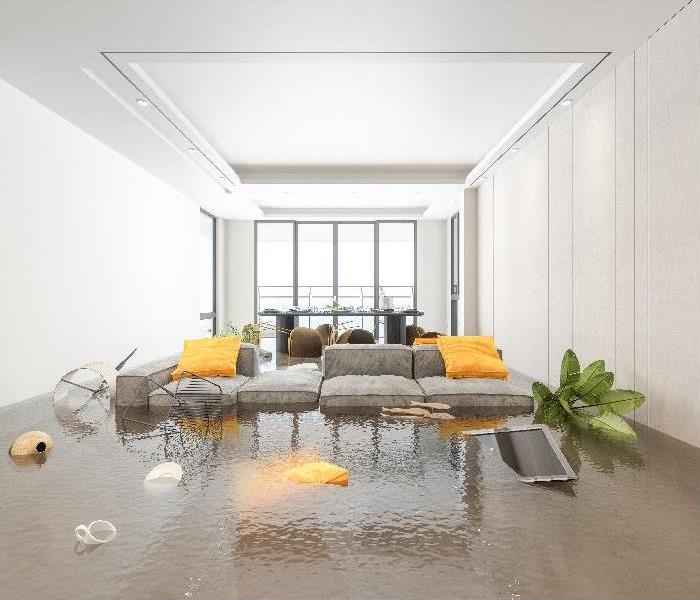How Do I Know Where the Floodwater Went in your Brooklyn home?
8/13/2020 (Permalink)
 SERVPRO is ready to handle any size flood damage 24/7, and make the damage to your property, “Like it never even happened.”
SERVPRO is ready to handle any size flood damage 24/7, and make the damage to your property, “Like it never even happened.”
SERVPRO brings multiple types of detection equipment to locate and remove the water from your Brooklyn home thoroughly
Floodwater in your home can be a frustrating event for a homeowner. The water may be standing, or other cases appear to have receded when it has instead seeped under flooring or wicked into the sheetrock or wound up in the neighbor's house in the unit next door. All of these issues require more than a visual inspection to locate the areas that need extraction and drying. SERVPRO techs bring various types of detection equipment to ensure that all areas of collected moisture get found and addressed as rapidly as possible.
Can Wet Sheetrock Recover From Flood Damage?
When water comes into contact with sheetrock in your Brooklyn property, the flood damage can have different outcomes depending on:
• How long the exposure took place
• The length of time before the cleanup started
• If the sheetrock shows signs of deterioration
• The nature of the water, whether it is clean or groundwater
• Buckling walls or sagging ceilings can present a danger to people in the vicinity, and to the technicians that perform controlled demo actions as needed
When scoping the property and tracking down all the areas of water migration, the technicians take special care to determine if the building materials can get dried in place. If the sheetrock has too much deterioration from water exposure, the techs try to limit the amount that gets removed by locating and measuring several inches over the waterline and only removing the damaged portion. While this action assists in drying the structure by opening up walls or ceilings as needed, it also makes repairs simple as a cut piece of sheetrock can get fitted in and then sealed in using joint compound and sanding for a smooth finish. Once the area gets primed and painted, there will be no sign of the previous problem.
Is It Easier to Tell if Floodwater is Contaminated by Sight or Odor?
Although floodwater carries a recognizable odor, there is no way to look at water and know what is in it. The techs use different types of testing to determine the presence of any harmful bacteria or pathogens and apply the appropriate water treatments to lessen the chance of injury during the handling of the water during extraction and disposal.
Carpet has two primary outcomes after storm damage when the carpet gets wet through a broken window from high winds and rain enters the home, it has restoration potential as long as the mitigation begins quickly. The water in the house has not been allowed to degrade.
Instead of testing for contaminants, SERVPRO technicians use their equipment to test the carpet materials to choose the best cleaning method. The techs look for:
• The composition of materials that make up the carpet fibers to determine if shrinkage is a potential issue
• Testing of the colorfastness of the dyes used on the threads
• Examination of the backing to ensure it has not deteriorated due to exposure to water
• If water spots are an issue, the techs can address those as a final step
In situations where groundwater has gotten absorbed into the carpet, it requires disposal using the protocols as biohazard removal due to the contaminated nature of the water. Because wet carpet is so heavy and can cause injury to lift, the techs extract the water and cut it into strips for faster and more efficient removal.
How Can I Avoid Issues with Mold?
Microscopic airborne mold spores float harmlessly inside and out most of the time, and unless conditions are right for germination, they pose no threat. After floodwater in a home creates an elevated air moisture environment, the spores can find a hospitable place and begin to grow, particularly on sheetrock and wood. SERVPRO techs have extensive training and certification for mold remediation #00055 to neutralize the colonies before the problem becomes an infestation through the use of their drying equipment, professional-grade antimicrobial cleaning agents and follow up treatments such as sealants to inhibit any return.
How Do I Get Repairs Made After Floodwater Ruins Things in My Home?
When the cleanup of the home gets completed, the techs walk the property owner through and go over the components that needed removal and items that got restored. Areas where sheetrock needs replacing or other necessary repairs can also get done by SERVPRO. With their general contractor license, the techs have the knowledge and experience to do:
• Any size reconstruction
• Painting
• Installation of flooring
• Plumbing repairs
• Electrical repairs
SERVPRO of Northwest Brooklyn at (718) 522-4400 is ready to handle any size flood damage 24/7, and make the damage to your property, “Like it never even happened.”






 24/7 Emergency Service
24/7 Emergency Service